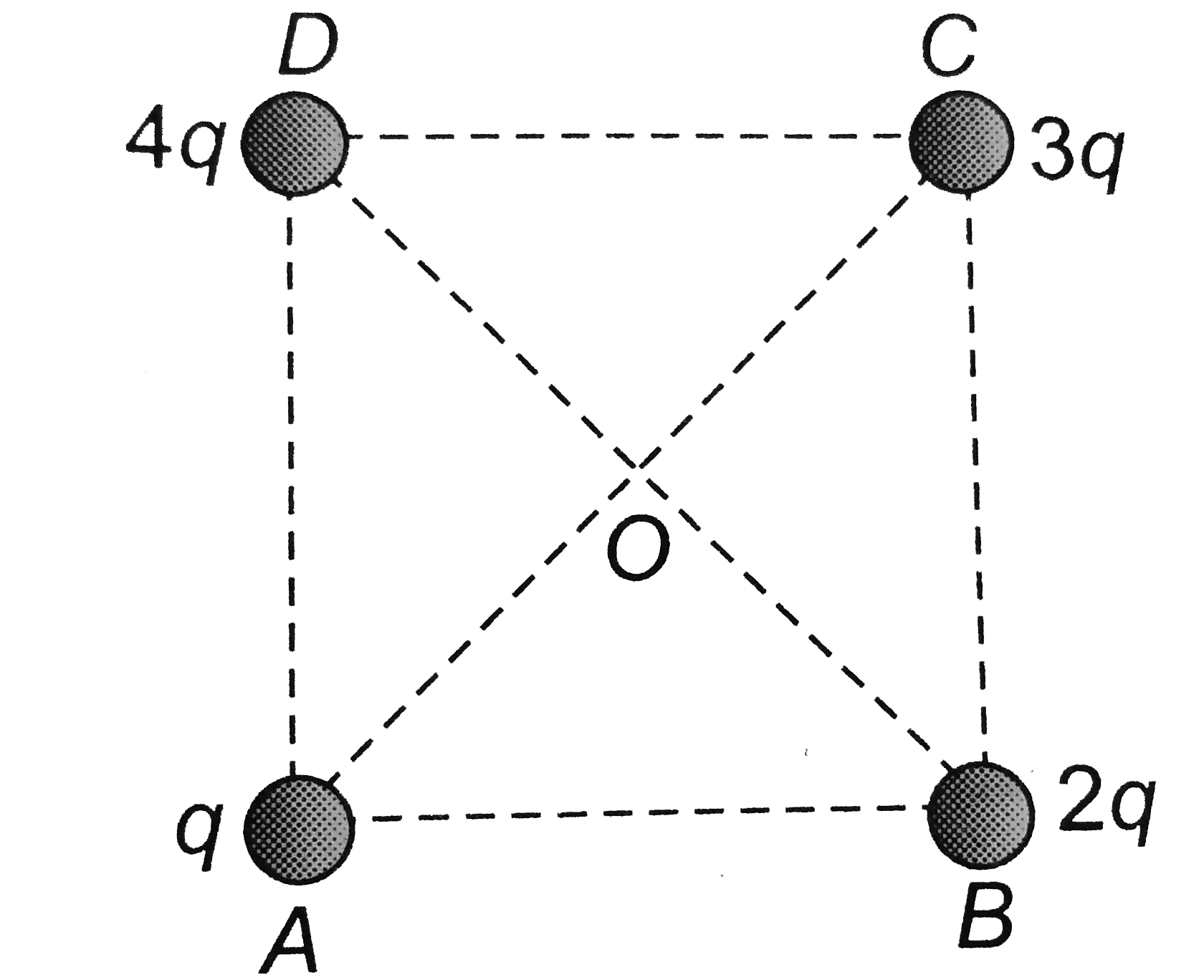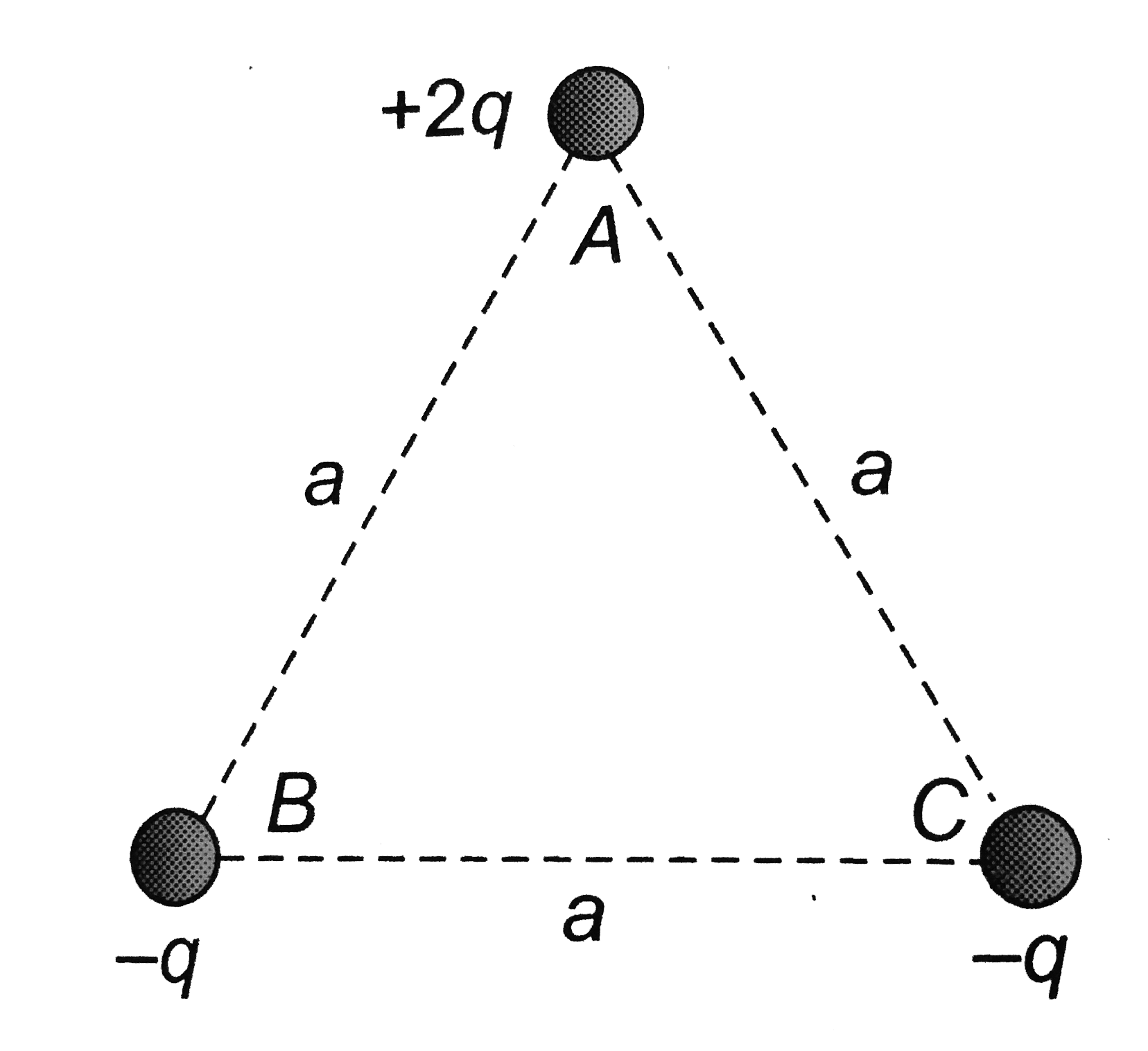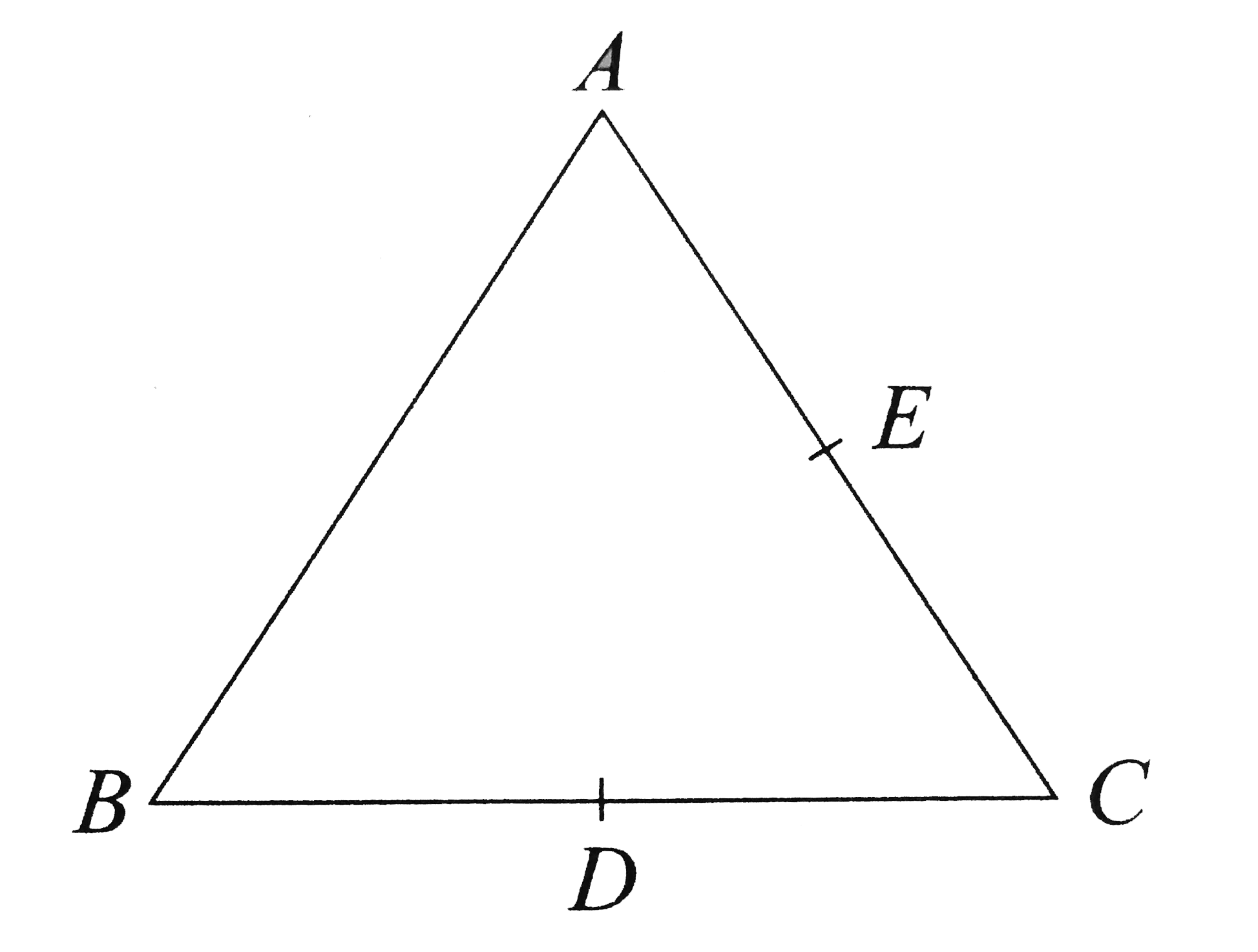Four charges +q,+q,−q,and−q are placed, respectively, at the corners A,B,C,andD of a square of side a, arranged in the given order. EandF are the midpoints of sides BCandCD, respectively, O is the center of square.
The work done in carrying a charge e from O to E is.
√2qeπε0a
qeπε0a[1√5−1]
qeπε0a[1√5+1]
zero
The correct Answer is:D
To solve the problem of finding the work done in carrying a charge e from point O (the center of the square) to point E (the midpoint of side BC), we will follow these steps:
1. Identify the Charges and Their Positions:
- We have four charges: +q at point A, +q at point B, −q at point C, and −q at point D.
- The square has a side length of a. The coordinates of the corners are:
- A(0,0)
- B(a,0)
- C(a,a)
- D(0,a)
- The midpoints are:
- E(a,a2)
- F(a2,a)
- The center O of the square is at (a2,a2).
2. Calculate the Electric Potential at Point O:
- The electric potential V at a point due to a point charge is given by:
V=14πϵ0qr
- The distance from O to each charge is:
- OA=OB=OC=OD=a√2
- Therefore, the potential at O due to all four charges is:
VO=VA+VB+VC+VD
VO=14πϵ0⎛⎜⎝qa√2+qa√2−qa√2−qa√2⎞⎟⎠
VO=14πϵ0⎛⎜⎝2qa√2−2qa√2⎞⎟⎠=0
3. Calculate the Electric Potential at Point E:
- The distance from E to each charge is:
- AE=a2
- BE=a2
- CE=a2
- DE=a√2
- The potential at E is:
VE=VA+VB+VC+VD
VE=14πϵ0⎛⎜⎝qa2+qa2−qa2−qa√2⎞⎟⎠
VE=14πϵ0⎛⎜⎝2qa2−qa√2−qa√2⎞⎟⎠
VE=14πϵ0⎛⎜⎝4qa−2qa√2⎞⎟⎠
VE=0(after simplification)
4. Calculate the Work Done:
- The work done W in moving a charge e from O to E is given by:
W=e(VE−VO)
- Since both VE and VO are zero:
W=e(0−0)=0
Final Answer
The work done in carrying the charge e from O to E is zero.
- We have four charges: +q at point A, +q at point B, −q at point C, and −q at point D.
- The square has a side length of a. The coordinates of the corners are:
- A(0,0)
- B(a,0)
- C(a,a)
- D(0,a)
- The midpoints are:
- E(a,a2)
- F(a2,a)
- The center O of the square is at (a2,a2).
- The electric potential V at a point due to a point charge is given by:
V=14πϵ0qr
- The distance from O to each charge is:
- OA=OB=OC=OD=a√2
- Therefore, the potential at O due to all four charges is:
VO=VA+VB+VC+VD
VO=14πϵ0⎛⎜⎝qa√2+qa√2−qa√2−qa√2⎞⎟⎠
VO=14πϵ0⎛⎜⎝2qa√2−2qa√2⎞⎟⎠=0
- The distance from E to each charge is:
- AE=a2
- BE=a2
- CE=a2
- DE=a√2
- The potential at E is:
VE=VA+VB+VC+VD
VE=14πϵ0⎛⎜⎝qa2+qa2−qa2−qa√2⎞⎟⎠
VE=14πϵ0⎛⎜⎝2qa2−qa√2−qa√2⎞⎟⎠
VE=14πϵ0⎛⎜⎝4qa−2qa√2⎞⎟⎠
VE=0(after simplification)
- The work done W in moving a charge e from O to E is given by:
W=e(VE−VO)
- Since both VE and VO are zero:
W=e(0−0)=0
The work done in carrying the charge e from O to E is zero.
Topper's Solved these Questions
- ELECTRIC POTENTIALBOOK - CENGAGE PHYSICS ENGLISHCHAPTER - ELECTRIC POTENTIALEXERCISE - Integer
5 Videos
- ELECTRIC POTENTIALBOOK - CENGAGE PHYSICS ENGLISHCHAPTER - ELECTRIC POTENTIALEXERCISE - DPP 3.1
14 Videos
- ELECTRIC POTENTIALBOOK - CENGAGE PHYSICS ENGLISHCHAPTER - ELECTRIC POTENTIALEXERCISE - Multiple Correct
10 Videos
- ELECTRIC FLUX AND GAUSS LAWBOOK - CENGAGE PHYSICS ENGLISHCHAPTER - ELECTRIC FLUX AND GAUSS LAWEXERCISE - MCQ s
38 Videos
- ELECTRICAL MEASURING INSTRUMENTSBOOK - CENGAGE PHYSICS ENGLISHCHAPTER - ELECTRICAL MEASURING INSTRUMENTSEXERCISE - M.C.Q
2 Videos
Similar Questions
Four charges +q,+q,−q,and−q are placed, respectively, at the corners A,B,C,andD of a square of side a, arranged in the given order. EandF are the midpoints of sides BCandCD, respectively, O is the center of square.
The electric potential at O is.
View SolutionFour charges +q,+q,−q,and−q are placed, respectively, at the corners A,B,C,andD of a square of side a, arranged in the given order. If O is the center of square.
The electric field at O is.
View SolutionFour charges of +q, +q +q and +q are placed at the corners A, B, C and D of s square. The resultant force on the charge at D
View SolutionFour charges of +q, +q +q and +q are placed at the corners A, B, C and D of s square. The resultant force on the charge at D
View SolutionCharges q,2q,3q and 4q are placed at the corners A,B,C and D of a square as shown in the following figure. The directon of electric field at the centre of the square is along

View SolutionCharges q,2q,3q and 4q are placed at the corners A,B,C and D of a square as shown in the following figure. The directon of electric field at the centre of the square is along

View SolutionThree charges of (+2q),(−q) and (−q) are placed at the corners A,B and C of an equilateral triangle of side a as shown in the adjoining figure. Then the dipole moment of this combination is

View SolutionFour point charges are respectively placed at the corners A, B, C and D of a square of side a. If F is the mid-point of side CD, the work done in carrying an electron of charge from O [the centre of the square] to F fill be:
View SolutionThree cahrges each+q, are placed at the corners of an isosceles trinagle ABC of sides BC and AC,2a,D and E are the mid-points of BC and CA. The work done in taking a charge Q from D to E is

View SolutionThree cahrges each+q, are placed at the corners of an isosceles trinagle ABC of sides BC and AC,2a,D and E are the mid-points of BC and CA. The work done in taking a charge Q from D to E is

View Solution